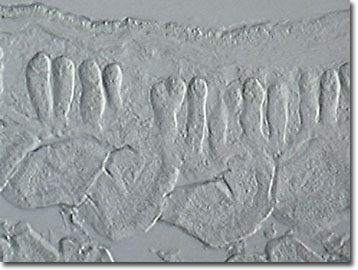Oblique Digital Image Gallery
Mouse Intestine Thick Section
Mouse intestines are very much like those of other vertebrate animals. The large intestine is wider and shorter than the small intestine and its primary function is to absorb water and electrolytes from digestive residues and store fecal matter. The word "mouse" has no meaning in scientific classification, but species of many families of small rat-like rodents are commonly referred to as mice.

View a lower magnification image of a mouse intestine thick section.
Most mouse species, such as the common house mouse, belong to the family Muridae. The other major mouse families are Cricetidae (grasshopper mice, harvest mice), Heteromyidae (pocket mice), and Zapodidae (jumping mice and birch mice). Mice occur in nearly every habitat and every continent but Antarctica, either naturally or through introduction by humans. Their diet consists of grains, roots, fruits, insects, grass, and "people food". The brownish-gray house mouse originated on the Eurasian continent but gained a worldwide distribution thanks to human dispersal and travel. These mice can multiply quickly, usually breeding every 10-17 weeks a year and producing 5 to 10 young per litter.
Laboratory mice are special breeds of house mice and are used in many scientific experiments because of their close mammalian relationship to humans. Compared to larger mammals, mice and other rodents are small, easy to handle, inexpensive to house, and breed quickly. During the late twentieth century (and on into the current century), scientists bred different strains of mice with genetic deficiencies in order to produce models for human diseases.
Contributing Authors
Cynthia D. Kelly, Thomas J. Fellers and Michael W. Davidson - National High Magnetic Field Laboratory, 1800 East Paul Dirac Dr., The Florida State University, Tallahassee, Florida, 32310.
BACK TO THE OBLIQUE IMAGE GALLERY
BACK TO THE DIGITAL IMAGE GALLERIES
Questions or comments? Send us an email.
© 1995-2025 by Michael W. Davidson and The Florida State University. All Rights Reserved. No images, graphics, software, scripts, or applets may be reproduced or used in any manner without permission from the copyright holders. Use of this website means you agree to all of the Legal Terms and Conditions set forth by the owners.
This website is maintained by our
Graphics & Web Programming Team
in collaboration with Optical Microscopy at the
National High Magnetic Field Laboratory.
Last Modification Friday, Nov 13, 2015 at 01:19 PM
Access Count Since September 17, 2002: 11482
Visit the website of our partner in introductory microscopy education:
|
|
